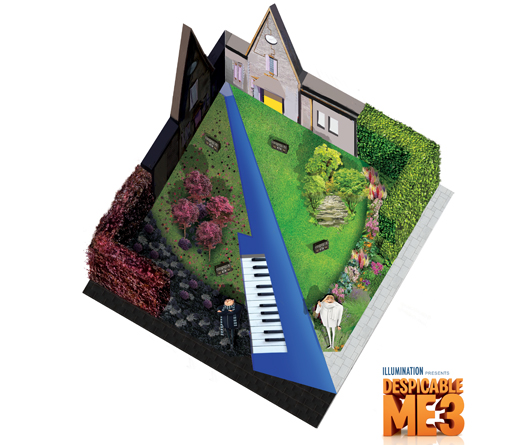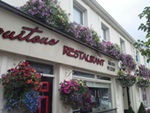![]()
Once I’d picked myself up off the floor having opened the invitation and itinerary to attend the SoSligo Food and Cultural Festival in June, the trip we were being taken on that really jumped out of the page was seaweed foraging with Prannie Rhatigan.
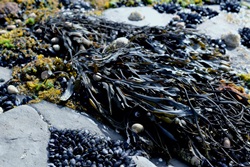
Sea or Mountain Woman?
I was born and reared within earshot of the sea and now living on top of a hill, almost an hour’s drive away from the coast, the deep yearning for sea air never goes away. I moved away from the seaside as a young child and my teenage years were spent close by to the salty marshes of Maldon, in North Essex, famed for its Sea Salt. I have no recollection of seaweed. Wistful memories tend to be of swimming every day with friends in the creeks, laying in bed listening to the bells ringing on stormy nights as they swayed violently on the tips of masts on yachts moored close by. Depending upon the wind direction, the sound of hammers and drills could often be heard echoing around the village as men worked in the boatyard on barnacle encrusted barges that sat resting, out-of-place high in the air on cradles, paint peeling from their hulls. The sounds were mirrored by the screech of the seagulls as they fought for morsels of food thrown from small fishing boats that lazily bobbed by.
But seaweed? I’m guessing there must have been some lying around the muddy marshes but it certainly wasn’t something we ate.
Edible Seaweed
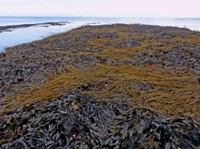
It came as a bit of surprise last year when I attended a fascinating talk about seaweed by Sally McKenna, author of Edible Greens, followed by a Japanese cookery demonstration by Fiona Uyema, that not only is seaweed edible, those in the know have eaten it for centuries and it’s packed full of properties that are tremendously good for us.
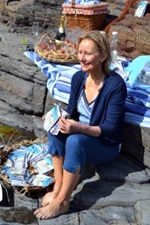
Prannie Rhatigan
Prannie was reared by the sea too but unlike me, she grew up learning its secrets. She describes in the introduction of her wonderful book, Irish Seaweed Kitchen how, as a child, she would help her father harvest the glistening seaweed on the edge of the Atlantic ocean throughout the various seaweed seasons. These days, as well as practising as a medical doctor, Prannie is sharing her knowledge and having stood spellbound in welly boots on the slippery rocks, surrounded by an abundant carpet of free and now I know, almost completely edible carpet of seaweed, I can safely tell you she really knows her stuff.
Prannie is not only passionate about seaweed in its raw and cooked forms, she’s also convinced of its health benefits and although her medical training dictates that she works from an evidence base, she can see that evidence building. She’s looking forward to seeing the day when seaweeds have mainstream preventative and therapeutic roles as anti-inflammatories, anti-cancer and antivirals among other things.
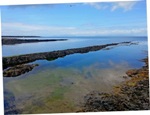
As we carefully wove our way around the slippery Sligo rocks, Prannie introduced us to these magnificent gifts from the sea that lay strewn around us, ensuring that we understood how to harvest seaweed responsibly, explaining that it wasn’t to be pulled out by its roots or from its mother plant, but snipped carefully and sustainably.

The waterproof Companion Guide to Edible Seaweeds that’s recently been launched to go with The Seaweed Kitchen has an illustration showing exactly where to cut each variety of seaweed with scissors, an invaluable guide to anyone new to seaweed foraging.
Seaweed might be free, but taking anything from the seashore in Ireland should be done respectfully and sustainably and Prannie was keen to point that out (see here for the Irish legislation about seaweed harvesting).

Sea spaghetti growing out from it’s parent plant
I could spend pages extolling the virtues of this cook book and guide with a difference, from its thoughtful bookmark that gives quick tips on preparing seaweed to the tried and tested recipes that include starters, canapés and deserts, compiled from local people’s favourite gems, or the thoughtful illustrations and photographs. The book and guide haven’t left my bedside since I arrived home as I’ve loved every moment dipping in and out of them, bringing me back to the seashore every time I do so.

During the foraging trip Prannie introduced us to her power packed green smoothie, sea spaghetti and cheese straws, as well as bladderwrack soaked in brandy. Who needs olives when you live by the sea…
You might wonder why someone who lives inland is so excited about a seaweed cookbook and the chances of foraging will be rare? Thankfully there are people who’ve created a business with folk like us in mind, selling little bags of dried seaweed that we can buy from specialist shops and online stores, re-hydrating them when we’d like. I now have a bag of sea spaghetti waiting to be turned into a salad dish I spotted in Prannie’s book, once I harvest my own cosmic purple carrots.

Bladderwrack & raspberries in elderflower fizz
If you’re interested in learning more about seaweed, there are several opportunities for you to forage along the clean waters of the Wild Atlantic Way. Prannie herself will be hosting a rather special sounding two-day course in the summer that would be a wonderful treat for someone special (treat yourself perhaps) or there are several other foragers dotted along the coastline. Failing that, buy the companion guide or a seaweed foraging book and see what you can find for yourself.
If you’d like to learn more about our seaweed walk, Irish TV accompanied us on our Sligo tour and you can view the episode below (usually found on Sky Channel 191). Susan from the Vibrant Ireland blog has also covered the foraging trip in a post here and has included a garlicy seaweed recipe conjured up by her husband Terry.
Have you discovered the hidden qualities of seaweed yet? Are you tempted?

Dee Sewell – a horticulturalist and certified trainer who started Greenside Up in 2009 and teaches people how to grow vegetables. Dee specialises in working with community gardens but also offers workshops, allotment visits, consultations, horticultural therapy, afterschools clubs as well as local talks – she tailors her services to meet clients needs. In 2012 Dee launched a Seed Gift Collection containing varieties of vegetable and insect friendly flowers with the aim of getting more people growing. Dee’s blog was a finalist in the 2012 Ireland Blog Awards in the Eco/Green and Lifestyle Categories.
Source: GreensideUp – Seaweed – A New Kind of Edible or A Centuries Old Secret? – Dee Sewell


